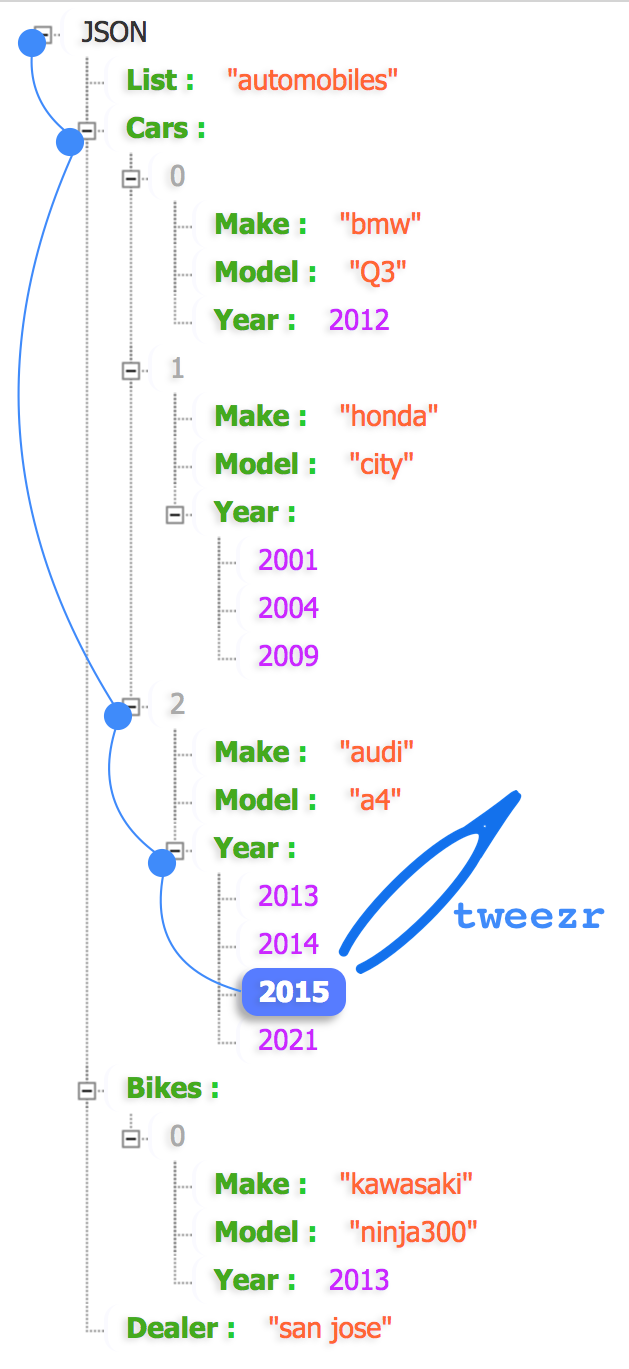tweezr
v2.0.1
Published
a module to reverse search values within a JSON structure or a javascript object & generate the dot-notation query selectors in context of the specified object. You may also use it to "walk" through the structure one step at a time to read/write values. T
Downloads
21
Maintainers
Readme
tweezr
a module to reverse search values within a JSON structure or a javascript object & generate the dot-notation query selectors in context of the specified object. You may also use it to "walk" through the structure one step at a time to read/write values. Think of it as an XPath generator for a matched keyword in a JS object (or a deserialized JSON).
| |
|:-:|
|
|:-:|
Install
npm install tweezr
Quickstart
Example JSON
$ cat auto.json
{
"list": "automobiles",
"cars": [
{
"make": "bmw",
"model": "Q3",
"year": 2012
},
{
"make": "honda",
"model": "city",
"year": [
2001,
2004,
2009
]
},
{
"make": "audi",
"model": "a4",
"year": [
2013,
2014,
2015,
2019,
2021
]
}
],
"bikes": [
{
"make": "kawasaki",
"model": "ninja300",
"year": 2013
}
],
"dealers": ""
}Example Usage
$ cat runner.js
var fs = require('fs');
var tweezr = require('tweezr').init({debug: false});
fs.readFile('auto.json', 'utf8', function(err, data) {
var myObj = JSON.parse(data);
var keyword = 2015;
var result = tweezr.findAll(keyword, myObj, 'myObj');
console.log('1. path of 1st node found: ' + result[0].path);
console.log('2. path of parent node: ' + result[0].parent().path);
console.log('2.1. key of parent node: ' + result[0].parent().key());
console.log('3. parent node serialized: ' + JSON.stringify(result[0].parent().val()));
console.log('4. path of previous sibling: ' + result[0].prev().path);
console.log('5. raw value of previous sibling: ' + result[0].prev().val());
console.log('6. path of previous to previous sibling: ' + result[0].prev(2).path);
console.log('7. raw value of previous to previous sibling: ' + result[0].prev(2).val());
console.log('8. path of next sibling: ' + result[0].next().path);
console.log('8.1. key of next sibling: ' + result[0].next().key());
console.log('9. raw value of next sibling: ' + result[0].next().val());
console.log('10. path of next to next sibling: ' + result[0].next(2).path);
console.log('11. raw value of next to next sibling: ' + result[0].next(2).val());
console.log('12. addAfter: ' + result[0].addAfter(1111).path);
console.log('13. add before next sibling: ' + result[0].next().addBefore(2222).path);
console.log('14. updated object serialized: ' + JSON.stringify(myObj));
console.log('15. replace a value: ' + result[0].replace([1,2,3]).val());
console.log('16. updated object: ' + JSON.stringify(myObj));
});Output
$ node runner.js
#console.log('1. path of 1st node found: ' + result[0].path);
1. path of 1st node found: myObj['cars'][2]['year'][2]
#console.log('2. path of parent node: ' + result[0].parent().path);
2. path of parent node: myObj['cars'][2]['year']
#console.log('2.1. key of parent node: ' + result[0].parent().key());
2.1. key of parent node: year
#console.log('3. parent node serialized: ' + JSON.stringify(result[0].parent().val()));
3. parent node serialized: [2013,2014,2015,2019,2021]
#console.log('4. path of previous sibling: ' + result[0].prev().path);
4. path of previous sibling: myObj['cars'][2]['year'][2]
#console.log('5. raw value of previous sibling: ' + result[0].prev().val());
5. raw value of previous sibling: 2015
#console.log('6. path of previous to previous sibling: ' + result[0].prev(2).path);
6. path of previous to previous sibling: myObj['cars'][2]['year'][2]
#console.log('7. raw value of previous to previous sibling: ' + result[0].prev(2).val());
7. raw value of previous to previous sibling: 2015
#console.log('8. path of next sibling: ' + result[0].next().path);
8. path of next sibling: myObj['cars'][2]['year'][3]
#console.log('8.1. key of next sibling: ' + result[0].next().key());
8.1. key of next sibling: 3
#console.log('9. raw value of next sibling: ' + result[0].next().val());
9. raw value of next sibling: 2019
#console.log('10. path of next to next sibling: ' + result[0].next(2).path);
10. path of next to next sibling: undefined
#console.log('11. raw value of next to next sibling: ' + result[0].next(2).val());
11. raw value of next to next sibling: undefined
#console.log('12. addAfter: ' + result[0].addAfter(1111).path);
12. addAfter: myObj['cars'][2]['year'][3]
#console.log('13. add before next sibling: ' + result[0].next().addBefore(2222).path);
13. add before next sibling: myObj['cars'][2]['year'][2]
#console.log('14. updated object serialized: ' + JSON.stringify(myObj));
14. updated object serialized: {"list":"automobiles","cars":[{"make":"bmw","model":"Q3","year":2012},{"make":"honda","model":"city","year":[2001,2004,2009]},{"make":"audi","model":"a4","year":[2013,2014,2222,2015,1111,2019,2021]}],"bikes":[{"make":"kawasaki","model":"ninja300","year":2013}],"dealers":""}
#console.log('15. replace a value: ' + result[0].replace([1,2,3]).val());
15. replace a value: 1,2,3
#console.log('16. updated object: ' + JSON.stringify(myObj));
16. updated object: {"list":"automobiles","cars":[{"make":"bmw","model":"Q3","year":2012},{"make":"honda","model":"city","year":[2001,2004,2009]},{"make":"audi","model":"a4","year":[2013,2014,[1,2,3],2015,1111,2019,2021]}],"bikes":[{"make":"kawasaki","model":"ninja300","year":2013}],"dealers":""}Documentation
.init( {debug: boolean} )
.findAll(varKeyword, objContextObject, strContextObjectLiteral)
Returns: An array of selector objects
Arguments:
- varKeyword: The item to be searched, sensitive of data-type and value
- objContextObject: The identifier of the haystack object (i.e. the object to search in)
- strContextObjectLiteral: The literal value of the haystack object identifier
.path
Type: Attribute
Value: the dot-notation selector query in context to objContextObject
.obj
Type: Attribute
Value: unserialized value of objContextObject
.key()
Type: Getter
Returns: the key of the key/value pair of the current selector
.val()
Type: Getter
Returns: the value of the key/value of the current selector
.parent([n])
Type: Getter
Returns: the Nth parent node of the current selector. Default is 1
.prev([n])
Type: Getter
Returns: the previous Nth sibling from the current selector. Default is 1
.next([n])
Type: Getter
Returns: the next Nth sibling from the current selector. Default is 1
.addAfter(varToInsert)
Type: Setter
Sets: Sets varToInsert as the raw value of the next node of the current selector
Returns: the selector object of the newly added node
.addBefore(varToInsert)
Type: Setter
Sets: Sets varToInsert as the raw value of the previous node of the current selector
Returns: the selector object of the newly added node
.replace(varToReplace)
Type: Setter
Sets: Sets varToInsert as the raw value of the currently selected node
Returns: the selector object of the same node
Acknowledgments/Credits
- Piyush Pattanayak - Thank you for helping with method chaining & several other valuable brainstorming sessions.
- Somasish Sahoo - Thank you for the numerous hours of valuable brainstorming sessions.

